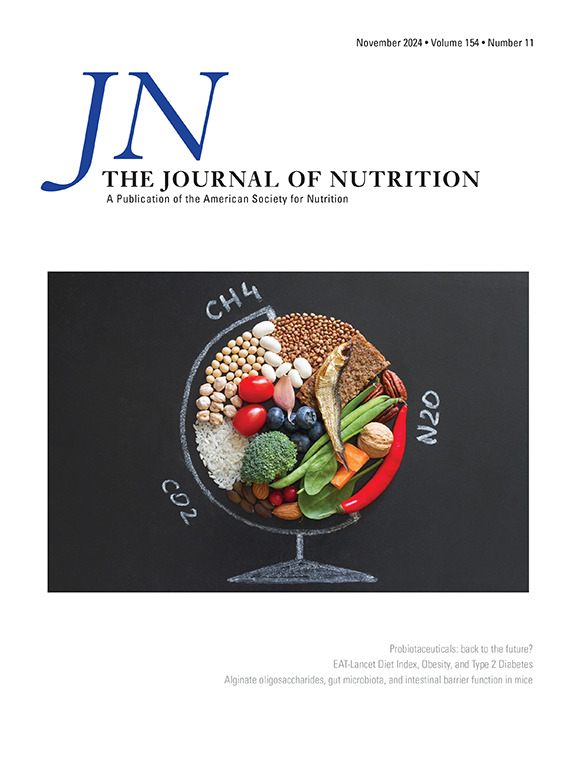DONALD队列研究中青少年和年轻人超加工食品摄入量与非目标代谢组学特征的关系。
IF 3.7
3区 医学
Q2 NUTRITION & DIETETICS
引用次数: 0
摘要
背景:由于超加工食品(UPF)对健康的负面影响,大量食用超加工食品继续引起公众对健康的极大关注。代谢组学有助于了解超高加工食品影响健康的生物机制:研究青少年摄入 UPF 的尿液和血浆代谢组学生物标志物:我们利用多特蒙德营养与人体测量纵向设计(DONALD)研究的数据,通过3d称重饮食记录(3d-WDR)和24小时尿液样本(n = 339)调查了青少年UPF摄入量与尿液代谢物浓度的横断面关联,并通过血液测量前5年内3至6次3d-WDR(n = 195)调查了年轻成年人重复评估的UPF摄入量与循环血浆代谢物浓度的关联。采用基于质谱的代谢组学方法对尿液和血浆样本进行分析。采用稳健稀疏主成分分析法确定生物样本特异性代谢物模式。应用多变量线性回归模型评估了UPF摄入量(占总食物摄入量的百分比,以克/天计)与单个代谢物浓度和代谢物模式得分之间的关系:青少年摄入 UPF 的中位比例为 22.0%(四分位数间距:12.3, 32.9),青壮年为 23.2%(四分位数间距:16.0, 31.6)。我们在尿液和血浆样本中分别发现了 42 种和 6 种与 UPF 摄入量相关的代谢物。一种尿液代谢物模式 "异种生物和氨基酸"(β = 0.042,95% 置信区间:0.014,0.070)和一种血浆代谢物模式 "脂质、异种生物和氨基酸"(β = 0.074,95% 置信区间:0.031,0.117)与 UPF 摄入量呈正相关。两种模式共有 29 种代谢物,其中大部分是异生物代谢物:我们发现了与青少年UPF摄入量相关的尿液和血浆代谢物,它们可能代表了UPF影响新陈代谢和健康的一些生物机制。本文章由计算机程序翻译,如有差异,请以英文原文为准。
Association of Ultraprocessed Foods Intake with Untargeted Metabolomics Profiles in Adolescents and Young Adults in the DONALD Cohort Study
Background
High consumption of ultraprocessed foods (UPFs) continues to draw significant public health interest because of the associated negative health outcomes. Metabolomics can contribute to the understanding of the biological mechanisms through which UPFs may influence health.
Objectives
To investigate urine and plasma metabolomic biomarkers of UPF intake in adolescents and young adults.
Methods
We used data from the Dortmund Nutritional and Anthropometric Longitudinally Designed study to investigate cross-sectional associations of UPF intake with concentrations of urine metabolites in adolescents using 3d weighed dietary records (3d-WDR) and 24-h urine samples (n = 339), and associations of repeatedly assessed UPF intake with concentrations of circulating plasma metabolites in young adults with 3–6 3d-WDRs within 5 y preceding blood measurement (n = 195). Urine and plasma samples were analyzed using mass spectrometry-based metabolomics. Biosample-specific metabolite patterns (MPs) were determined using robust sparse principal components analysis. Multivariable linear regression models were applied to assess the associations of UPF consumption (as a percentage of total food intake in g/d) with concentrations of individual metabolites and MP scores.
Results
The median proportion of UPF intake was 22.0% [interquartile range (IQR): 12.3, 32.9] in adolescents and 23.2% (IQR: 16.0, 31.6) in young adults. We identified 42 and 6 UPF intake-associated metabolites in urine and plasma samples, respectively. One urinary MP, “xenobiotics and amino acids” [β = 0.042, 95% confidence interval (CI): 0.014, 0.070] and 1 plasma MP, “lipids, xenobiotics, and amino acids” (β = 0.074, 95% CI: 0.031, 0.117) showed positive association with UPF intake. Both patterns shared 29 metabolites, mostly of xenobiotic metabolism.
Conclusions
We identified urine and plasma metabolites associated with UPF intake in adolescents and young adults, which may represent some of the biological mechanisms through which UPFs may influence metabolism and health.
求助全文
通过发布文献求助,成功后即可免费获取论文全文。
去求助
来源期刊

Journal of Nutrition
医学-营养学
CiteScore
7.60
自引率
4.80%
发文量
260
审稿时长
39 days
期刊介绍:
The Journal of Nutrition (JN/J Nutr) publishes peer-reviewed original research papers covering all aspects of experimental nutrition in humans and other animal species; special articles such as reviews and biographies of prominent nutrition scientists; and issues, opinions, and commentaries on controversial issues in nutrition. Supplements are frequently published to provide extended discussion of topics of special interest.
 求助内容:
求助内容: 应助结果提醒方式:
应助结果提醒方式:


